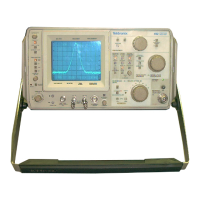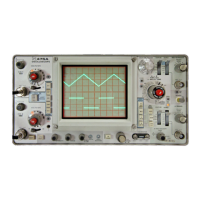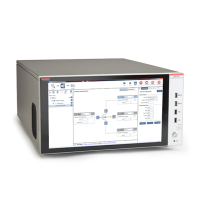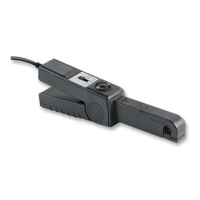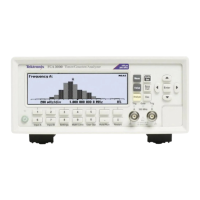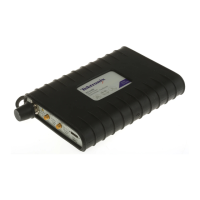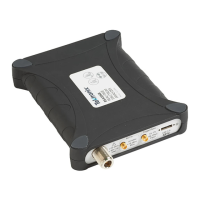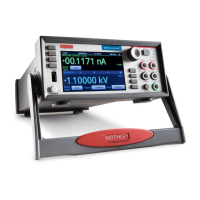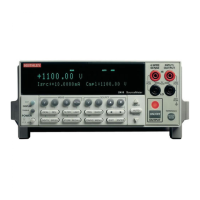TABLE 6-9
Suggested Frequency
Band
Sensitivity
Signal Generator
(Equal to or better than)
Dial Accuracy
(Refer to equipment list)
100 kHz
1 kHz
Check Frequency
Hewlett-Packard
10 MHz
Model 608D
140
1
-80 dBm -100 dBm
Every 10 MHz
275
275
2
400
-90 dBm -110 dBm
Every 100 MHz
Hewlett-Packard
900
Model 612A
850
Hewlett-Packard
1.5 GHz
3
-85 dBm -105 dBm
Every 500 MHz
Model 8614A
2.0
1.5
Hewlett-Packard
2.5
4
1
-90 dBm -110 dBm
Every 1.0 GHz
Model 8616A
4.0
4.0
Polarad
6.0 5
1
-80 dBm
-100 dBm
Type 1107
8.0
Polarad
8.0
Type 1108
10.0
6
1
-75 dBm -95 dBm
Hewlett-Packard
12.0
Model 626A
12.4
15.0
7
2
-70 dBm
-90 dBm
Hewlett-Packard 18.0
Model 628A
18.0
Hewlett-Packard
25.0 8
2
-60 dBm -80 dBm
Model 938
Hewlett-Packard
26.5
Model 940 40.0 8
2
-50 dBm
-70 dBm
1
Sensitivity is specified at the mixer input.
Insertion loss through the cable, at the higher (GHz) frequency range, will become significant. Fig.
645 is a graph that shows the approximate loss in dB for a 6 foot coaxial cable.
2
When checking the sensitivity of scales 7 and 8, apply the source signal to the Waveguide Mixer, then connect the Waveguide Mixer to the
Mixer Adapter-through the 2 foot cable with TNC connectors.
2) Center the FINE RF CENTER FREQ control. Depress the
LOCK CHECK button and adjust the RF CENTER FREQ con-
trol until a beat frequency is displayed.
3) Adjust the FINE RF CENTER FREQ control for a lock
condition or until the beat reduces to zero (zero beat).
4) Repeat the above procedure with a 5 MHz signal from
the signal generator.
5) Increase the input signal amplitude to 5 V peak to
peak and repeat the check with the increased signal ampli-
tude at 5 MHz and 1 MHz.
38B. Alternate Procedure to Check Dial Accur-
acy, Oscillator Mixer ‘Operation and Ef-
fectiveness of Local Oscillator Phase Lock
a. Equipment setup is shown in Fig. 6-46.
b. Apply 100 MHz (10 ns) markers from the marker output
of the time-mark generator through the harmonic generator,
the 200 MHz trap, and the 20 dB attenuator to the band B
RF INPUT connector.
c. Switch the band selector to B. Set the DISPERSION to
2 MHz/div and switch the VERTICAL DISPLAY selector to
LOG.
d. Check the dial accuracy as follows:
1) Tune the RF CENTER FREQUENCY through the band.
Observe the 100 MHz harmonics and their image spurii as
they travel across the screen towards the center and merge
with the IF feedthrough response, as the dial crosses a fre-
quency check point. The harmonics then separate and move
off the screen. See Fig. 6-47. Maximum error between the
dial readings and frequency check points must not exceed
± (2 MHz + 1% of the dial reading).
2) Adjust the MIXER PEAKING control to optimize signal
amplitude. Note the spectral display of the harmonic genera-
tor signals. Tune the RF CENTER FREQUENCY through the
band, checking for dead spots which could be caused by
either local oscillator failure or mixer malfunction. The MIXER
PEAKING must be peaked at all check points.
e. Check-Local oscillator phase lock operation as follows:
1) Turn the INT REF FREQ control on. Decrease the DIS-
PERSION to 500 kHz/div.
2) Depress the LOCK CHECK button and adjust the FINE
RF CENTER FREQ control to position the display to the center
of the graticule area. Release the LOCK CHECK button.
3) Shift the IF feedthrough response approximately 2
divisions off center with the IF CENTER FREQ control, then
6-43

